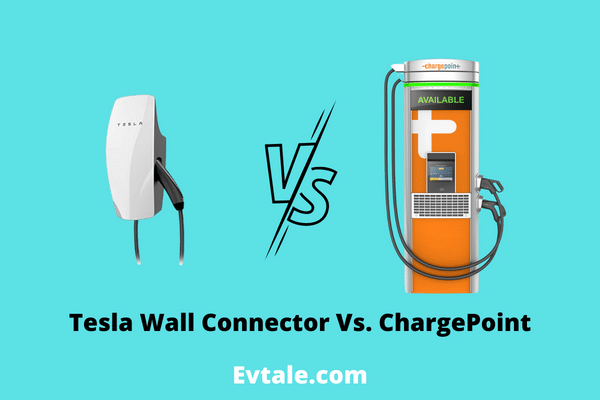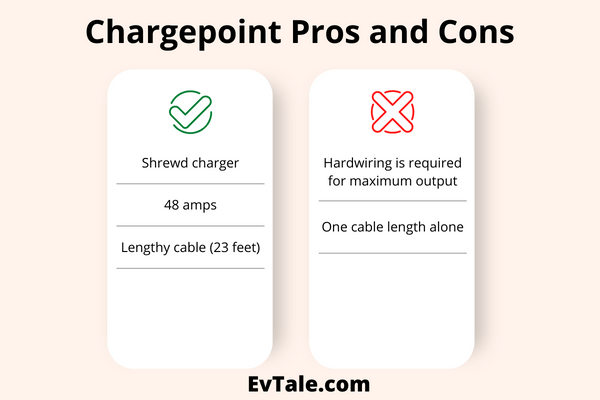Tesla Wall Connector Vs ChargePoint ? Knowing which charger to use for your electric car (EV) can be challenging. The most recent wall connector is a solid option if you want reliable charging with a Tesla connector.
However, the Chargepoint is a fantastic option if you want an adaptor that can endure frigid temperatures and has a typical North American plug.
After reading this article, you should have a better idea of which one to select because it will highlight their best qualities and show how they stack up against one another.
Tesla Wall Connector Vs ChargePoint : Characteristics
The 48 maximal amp output and the truth that both chargers are incredibly dependable smart one share two similarities. Both are produced by well-known brands and have warranties.

Let’s look at these in a little more detail now:
48 Amps
First off, the combined output of both is 48. This also implies that both need a 60 amp connection to deliver their work.
Smart Chargers
The fact that they are also smart chargers is another commonality. This indicates that both are app-enabled. Both programs allow you to create a profile, and you can use Wi-Fi to operate.
Warranty
A warranty is included with both of them. The ChargePoint has a three-year guarantee, while the other one has a four-year warranty.
Your car will recharge more slowly as little as the amps are. Therefore, searching for an adaptor that provides at least 40 amps is wise. These are great options for speedy EV charging because they have up to 48 outputs.
Both are advanced, although Tesla is still under development. Power-sharing is one feature of the smart charger that functions, but other improvements haven’t been made public yet.
Chargepoint is integrated with a terrific mobile application and offers all functionality.
Let’s examine their advantages and disadvantages now that you know their main points in common.
Advantages and Disadvantages
The power-sharing feature, stylish appearance, and practical, innovative software are the key benefits. Cons include the lack of a universal connector and the fact that it struggles in cold weather.
Here are the main benefits and drawbacks of the Tesla Wall Connector:
Pros
- 48 amps
- sleek style
- Power-sharing
Cons
- It struggles in low-freezing conditions.
- There is no universal connector on it.
- Only 18 feet of cable is the largest.
- It should be hardwired.
Read : Tesla Wall Connector vs Mobile Connector [Comparison]
The wall connector has a sleek, contemporary appearance that fits almost anywhere. It doesn’t appear bulky and won’t in any way harm the formation of space.
The main advantage of the wall is power sharing. You can connect many adapters to a single circuit via sharing power. So, if you have a lot of EVs, they can all charge equally.
You may also manage using the app if you have Wi-Fi connectivity.
Ensure that the weather doesn’t get too chilly if you intend to keep your charger outside. Although the wire will freeze and become difficult to handle, it will still function in cold temperatures. It is advised to pick the Chargepoint if you are in a frigid area.
Another drawback is that all walls lack the standard North American plug. Instead, they include a connector explicitly made for Tesla. This implies that if you own another EV and wish to use the Tesla wall, you will need to purchase an adaptor.
For the most recent wall charger, the longest wire length is 18 feet. This is a significant scam because many cables available on the market are longer than this. Even while 18 feet might be a sufficient length for some, it is still less flexible.
A wall must be hardwired, not plugged in. To install it safely, you’ll probably need to hire an electrician, which can be expensive and time-consuming.
The Chargepoint key benefits are that it is a smart charger, extremely robust in cold weather, and has an incredibly long cord (23 feet). There aren’t many drawbacks, but one minor one is that if you want the highest amp output, it must be hardwired.
Pros
- Shrewd charger
- 48 amps
- Lengthy cable (23 feet)
Cons
- Hardwiring is required for maximum output.
- One cable length alone
It must be hardwired if you wish to receive the full power of 48 amps. If not, all you have to do is plug it in. Since you’ll have to pay an electrician to install it for you, this can be a minor inconvenience. That’s one of the only drawbacks, though.
The sophisticated application is one of its best features. When utilizing public ChargePoint, you can use your application to enable Alexa, set a timer and alerts, view your purchasing record…
This is undoubtedly a perk if you enjoy ordering Alexa around.
The 23-foot cable’s length is a big plus. Additionally, you may quickly shift the cord around to meet your needs if you park in an inconvenient spot or far from the charge station.
A 60 amp circuit is required if you want to provide your EV with a total of 48 amps. Your car won’t accept 48 amps if you don’t, and it will charge more slowly. A 60 amp circuit isn’t necessary if you don’t mind charging your EV more slowly.

- Tesla Wall Connector Vs Third Party
- Tesla Wall Connector Vs Juicebox
- Tesla Wall Connector Vs Nema 14-50
How To Choose : Wall Connector Vs ChargePoint
Chargepoint’s superior build quality, lengthier connection, and innovative application perform marginally better than the wall. Additionally, it works with all EVs. The Tesla functions well, but any devices that aren’t Teslas need adapters.
Not that the Ev wall isn’t worthwhile, though. It is top-notch that can provide 48 amps while still having a trendy, contemporary appearance. Even though they are generally unimportant, there are still more concerns with the charger.
Compared to the Tesla, the Chargepoint is far more versatile. An adaptor is provided with each. This implies that you may easily use the free converter that comes with your car to link your vehicle to a Chargepoint.
However, no other EV is provided with a Tesla-compatible converter. Therefore, if you have several EVs of various brands, it isn’t worthwhile to get a Tesla.